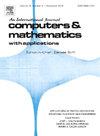Two-level dynamic load-balanced p-adaptive discontinuous Galerkin methods for compressible CFD simulations
IF 2.9
2区 数学
Q1 MATHEMATICS, APPLIED
引用次数: 0
Abstract
We present a novel approach utilizing two-level dynamic load balancing for p-adaptive discontinuous Galerkin (DG) methods in compressible Computational Fluid Dynamics (CFD) simulations. The high-order explicit first stage, specifically the singly diagonal implicit Runge–Kutta (ESDIRK) method, is employed for time integration, where the pseudo-transient continuation is integrated with the restarted generalized minimal residual (GMRES) method to handle the solution of nonlinear equations at each stage of ESDIRK, excluding the initial stage. Relying on smoothness indicators, we carry out the refinement/coarsening process for p-adaptation with dynamic load balancing. This approach involves a coarse level (distributed memory) decomposition based on MPI paradigm and a fine level (shared memory) decomposition based on OpenMP paradigm, enhancing parallel efficiency. Dynamic load balancing is achieved by computing weights based on degrees of freedom, ensuring balanced computational loads across processors. The parallel computing framework adopts either a graph-based type (ParMETIS and Zoltan) or space-filling curves type (GeMPa) for coarse level partitioning, and a graph-based type (METIS and Zoltan) for fine level partitioning. The effectiveness of the method is demonstrated through numerical examples, highlighting its potential to significantly improve the scalability and efficiency of compressible flow simulations. The numerical simulations were conducted using the CODA flow solver, a state-of-the-art tool developed collaboratively by the French National Aerospace Center (ONERA), the German Aerospace Center (DLR), and Airbus.
用于可压缩 CFD 模拟的两级动态负载平衡 p 自适应非连续伽勒金方法
我们提出了一种在可压缩计算流体动力学(CFD)模拟中利用两级动态负载平衡来实现 p 自适应非连续伽勒金(DG)方法的新方法。采用高阶显式第一阶段,特别是单对角隐式 Runge-Kutta (ESDIRK) 方法进行时间积分,其中伪瞬态延续采用重启广义最小残差 (GMRES) 方法进行积分,以处理 ESDIRK 每个阶段(不包括初始阶段)的非线性方程求解。根据平滑度指标,我们对具有动态负载平衡功能的 p 适应性进行了细化/粗化处理。这种方法包括基于 MPI 模式的粗级(分布式内存)分解和基于 OpenMP 模式的细级(共享内存)分解,从而提高了并行效率。动态负载平衡是通过计算基于自由度的权重来实现的,从而确保各处理器之间的计算负载平衡。并行计算框架采用基于图的类型(ParMETIS 和 Zoltan)或空间填充曲线类型(GeMPa)进行粗分区,采用基于图的类型(METIS 和 Zoltan)进行细分区。通过数值示例证明了该方法的有效性,突出了其显著提高可压缩流模拟的可扩展性和效率的潜力。数值模拟使用 CODA 流动求解器进行,这是法国国家航空航天中心(ONERA)、德国航空航天中心(DLR)和空中客车公司合作开发的最先进工具。
本文章由计算机程序翻译,如有差异,请以英文原文为准。
求助全文
约1分钟内获得全文
求助全文
来源期刊

Computers & Mathematics with Applications
工程技术-计算机:跨学科应用
CiteScore
5.10
自引率
10.30%
发文量
396
审稿时长
9.9 weeks
期刊介绍:
Computers & Mathematics with Applications provides a medium of exchange for those engaged in fields contributing to building successful simulations for science and engineering using Partial Differential Equations (PDEs).
 求助内容:
求助内容: 应助结果提醒方式:
应助结果提醒方式:


